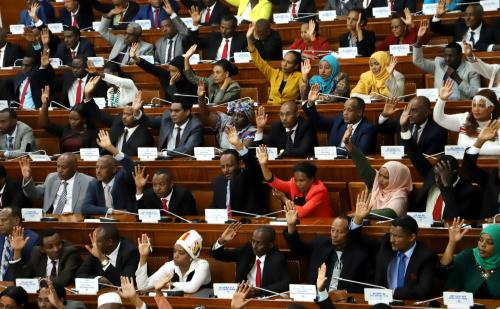African policymakers and scholars try to learn from Asia—from both its successes and failures. However, the challenge often is finding lessons that match their starting positions as “late” latecomers to industrialization. Thankfully, recent research—in particular, the new book “Resurgent Asia: Diversity in Development” by Deepak Nayyar—has identified lessons that have direct relevance for African countries and their current development trajectory.
Diversity in development and growth trajectory
The Asian experience shows that diversity in development paths is the rule rather than the exception. While there are some discernible patterns, generally, Asia’s transformation illustrates the diverse paths that countries have taken in their development. In this way, the lessons for African countries are threefold: First, there is no prescribed path or magic wand that can be leveled as the “Asian model” and applied elsewhere; second, even late latecomers traveling along their own paths have the opportunity to catch up; and, finally, instead of searching for a “one-size-fits-all” model, African countries should discover and pursue their own economic development paths based on their own specific conditions and contexts. In fact, Africa’s recent experience confirms these lessons. For instance, Ethiopia, Kenya, and Ghana are examples of success stories over the last two decades. Notably, they each have taken different paths: Ethiopia’s growth was achieved by pursuing an “unorthodox” economic development model and the principles of “policy independence,” while Ghana and Kenya followed what may be broadly regarded as mainstream orthodoxy and the economic liberalization prescriptions of the Washington Consensus, where the role of the state and active industrial policy is less significant.
The lesson for African countries is clear
Nayyar’s book argues that Asia’s transformational journey toward industrialization required sustained technological capability and technological learning. The role of the state as a leader, catalyst, and supporter of economic development—albeit playing different roles in different sectors, countries, and development stages—was critical in its success. Asia’s experience also illustrates that openness works well for industrialization and transformation—but only when complemented by strategic action and effective industrial policy.
In this way, African countries’ ambition to industrialize and climb up the development ladder will not be possible without sustained state support for enhancing technological capability and learning. Equally important is the leadership provided by an active and supportive state guided by a strategic industrial policy framework.
Afro-pessimism and the African dummy
An important lesson from Asia’s economic transformation is that policy learning by government and technological learning by firms are key ingredients for catch-up. While industrial development patterns differ between African countries, interestingly, some of them are already following the Asian approach of “dynamic learning,” both technological and policy learning. As Ethiopia’s successful floriculture and cement industries demonstrate, policy learning is an integral part of the policymaking process. Thus, both the standard Afro-pessimism view—the misrepresentation and ideologically driven bias that presumes African tragedy, often promoted by influential scholars—and the African-dummy research approach—an overly simplistic view that treats the continent as a homogenous entity and offers uniform diagnoses despite the huge diversity between and within its 54 countries, which denies African diversity and the capacity for “dynamic learning”—are erroneous.
Global insertion, openness, and colonial legacy
Insertion into the global economy and open macroeconomic policy environment were critical for Asia’s economic transformation and catch-up. The long history of well-structured states and cultures in Asia— unlike countries in Latin America and Africa—was also instrumental in Asian countries’ ability to pursue an independent policy and national development objectives. However, the important lesson for Africa from Asia’s experience is that global insertion becomes beneficial only when it is taken in the form of strategic integration, rather than passive insertion into the world economy. Similarly, openness is a necessary condition for creating a conducive environment for market development, though not on its own. Importantly, its effectiveness as a driver of industrialization depends on available effective industrial policy and an active state to implement it.
Latecomer advantage and “newness”
History shows that economic miracles occur in the least expected regions and countries: As the classical political economist Frederick List underlined in 1841, “No nation has been so misconstrued and misjudged as respects its future destiny and its national economy as the United States of North America, by theorists as well as by practical men.” The same observation could apply to Japan and the Asian latecomers’ industrialization in the 20th century. The relevant lesson for late latecomers in Africa is that lateness should not necessarily be an impediment to economic development and catch-up. A strategic approach to industrial policymaking and global insertion, “dynamic learning,” finding one’s own model of economic development, and having an active and catalytic state that provides leadership all resonate for African countries from Asia’s successful economic transformation experience.
Conclusion
The extraction of useful lessons must be based on robust research methodology and analytical perspectives. Through interdisciplinary, evidence-based, and historical analysis, Nayyar has identified the policy approaches that propelled Asia’s successful structural transformation and the lessons that can be drawn from them. For African countries, a useful lesson worth highlighting is the importance of the relationship between structural change and growth and the interface between these two critical processes. Equally important for sustained growth and structural transformation has been the synergies and complementarities between sectors and sectoral policies. The idea that the system is only as strong as the weakest link in the chain is another pertinent and applicable lesson that African countries can learn from Asia’s structural transformation experience.







Commentary
Asia’s economic transformation: Lessons for Africa
March 12, 2020